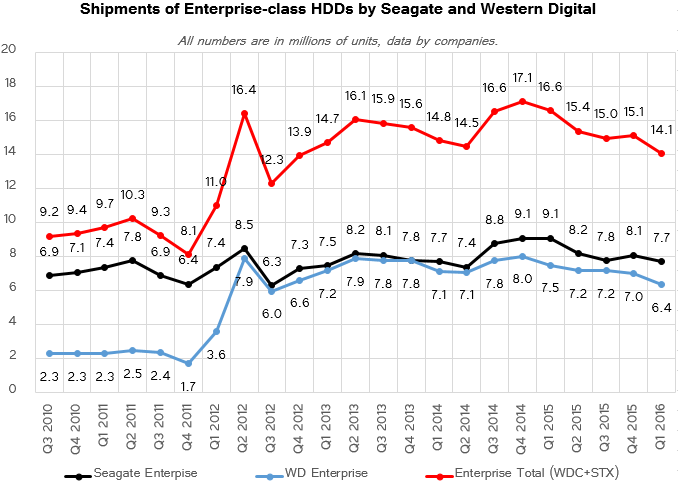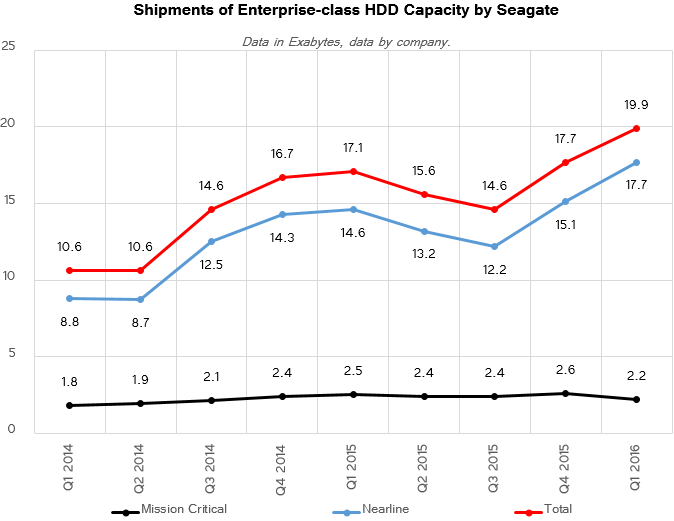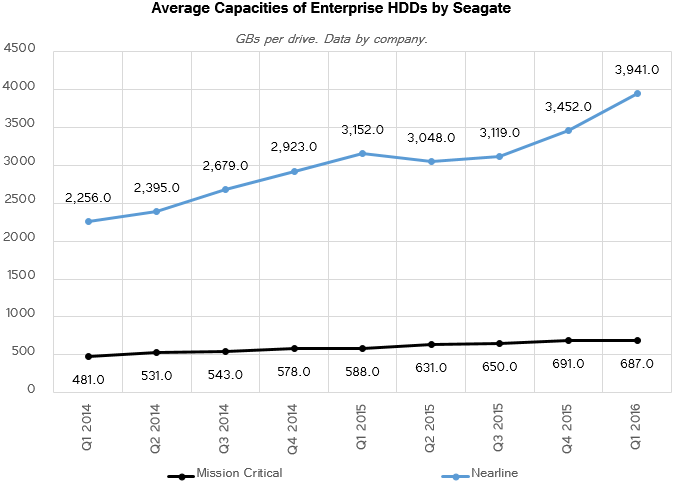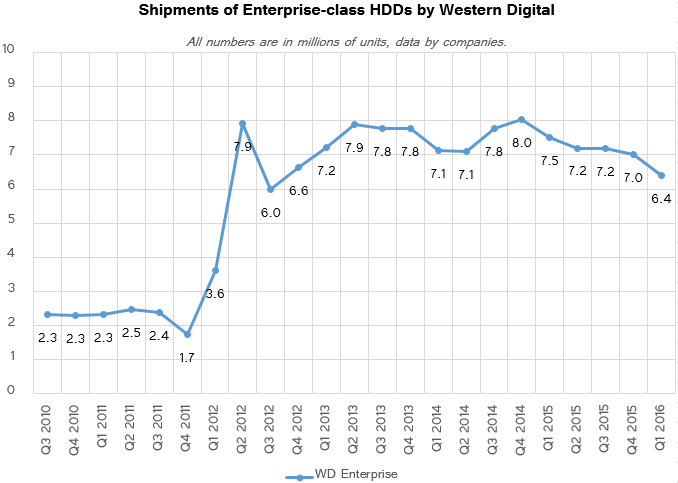Market Views: HDD Shipments Down 20% in Q1 2016, Hit Multi-Year Low
by Anton Shilov on May 12, 2016 8:00 AM ESTUnit Sales of Enterprise HDDs Decline, But There Is a Catch
Enterprise hard disk drives are arguably the most important and lucrative part of HDD makers’ business these days. Firstly, such drives have to use many leading-edge technologies in order to demonstrate very high performance, or offer very high capacities. Secondly, they are not shipped in huge volumes, but they are sold with huge premium because of the technologies as well as extended reliability. Finally, since many client devices no longer have HDDs, but still have to store files elsewhere, their data ends up in the cloud and stored on various datacenter-class HDDs. Basically, even if an HDD maker fails to sell a $50 drive for a low-end laptop, the data from that laptop will eventually be stored on a $300 - $600 nearline drive in a data center, compensating missed revenue to the HDD producer.
There are two types of enterprise-class hard drives:
- High-performance HDDs for mission-critical storage that feature 10K or 15K spindle speeds as well as SAS interface. Such drives compete against SSDs these days and their volumes are slowly declining. This trend has been ongoing for years now and hard drive makers perfectly understand it. Seagate, Toshiba and Western Digital also offer high-end mission critical SSDs with SAS interface to their customers and eventually the portfolio of such solid-state storage devices will only expand.
- Another type of enterprise HDDs are nearline (near online) drives that are used to store various data in data centers. Some of such drives are for cold archives, which are rarely accessed and are hardly ever modified. Such HDDs have 5400 RPM-class spindle speed and their main purpose is to store as much data as possible and at the lowest cost. Other drives are used to store frequently accessed and modified data, which is why they feature 7200 RPM spindle speed and various methods to improve their performance. These drives can be filled with helium to maximize storage space (allowing a reduced platter gap) and keep power consumption down to minimize TCO. Usage of nearline HDDs has been increasing in the recent years. More importantly, their capacities have been growing very rapidly.
It is very important to distinguish between the two types of enterprise-class hard drives not only because they are completely different from a technology point of view, but also because their market dynamics are poles apart. Unfortunately, until this quarter neither of HDD makers disclosed sales of mission critical and nearline drives separately, but only reported the number of enterprise-class HDDs sold. This quarter, Seagate published more or less precise details about its enterprise drives and their dynamics, which we will analyze below. In the meantime, let’s have a look at the shipments of both leading enterprise HDD suppliers.
Based on the numbers from Seagate and Western Digital, sales of enterprise-class hard drives from these two manufacturers declined to 14.09 million units in Q1 2016, which is 15% lower compared to the first quarter last year. Seagate remained the largest supplier of enterprise drives with 7.7 million units sold (down 15.4% YoY), whereas Western Digital supplied 6.39 million of enterprise hard disks (down 15% YoY). Toshiba also has a portfolio of high-end drives for servers, but while it has many products with a SAS interface, it does not participate in the high-end of the nearline market due to lack of 8 TB and 10 TB HDDs in its lineup.
Out of 7.7 million enterprise drives that Seagate shipped in the first quarter, 4.5 million HDDs were for nearline storage applications, whereas 3.2 million HDDs were designed for mission-critical apps.
Shipments of Seagate’s nearline HDDs were down 4.3% compared to the first quarter of 2015, but were slightly up sequentially. The company claims that it expected demand for such drives to be significantly weaker, which is why it could not even satisfy all the demand. During the quarter, Seagate ramped up production of its 8 TB HDD lineup and significantly increased shipments of such drives compared to the previous quarter, however, it could not meet all the demand. The company also supplied a large volume of qualification units of its 10 TB helium-filled hard drives aimed at the highest-end of the cloud market. Due to the 7200 RPM spindle speed and advanced caching sub-system, Seagate’s Enterprise Capacity 3.5 (Helium) 10 TB hard drive is among the fastest in the company’s lineup, challenging even 15K mission-critical drives when it comes to sustained transfer rates (of course, those small drives still have a lot of other advantages, including considerably higher IOPS, significantly lower latency, very high instantaneous transfer rates and so on). In April, the company started revenue shipments of its SATA 10 TB HDDs, which further indicates growing demand for such drives.
By contrast, shipments of mission-critical HDDs dropped 13.6% sequentially and 25.6% year-over-year. The company says that approximately 25% out of 3.2 million mission-critical HDDs are 15K drives, which are gradually replaced by SSDs in the data centers. Solid-state storage devices also challenge 10K HDDs, but the manufacturer expects this segment of the market to have a much longer transition horizon. Because of the economic situation and the market shift to SSDs, sales of mission-critical drives were 700K below Seagate’s original forecast in Q1 2016, the company said.
Given the fact that nearline drives have significantly higher capacities than mission critical drives, it is not surprising that they are driving enterprise storage capacities in terms of EB shipments.
Average enterprise HDD sold by Seagate in Q1 2016 could store 3.941 GB of data, up 25% from the first quarter of last year, which is a direct result of growing demand for capacities from various data center customers.
Western Digital does not break down sales of its enterprise HDDs into nearline and mission critical categories, but while the split may be slightly different, market trends affect both companies in the same way. In its conference call with financial analysts, the management of Western Digital confirmed that shipments of the company’s 15K HDDs are declining because many customers replace such HDDs with SSDs and also observed that many 10K HDD deployments begin to adopt SSDs. In addition, the company noted that in Q1 2016 it saw steeper than expected price declines in performance enterprise and capacity enterprise markets. In particular, the company blamed decreased prices of 4 TB and 8 TB nearline HDDs for its lowering gross margins.















116 Comments
View All Comments
nandnandnand - Thursday, May 12, 2016 - link
Don't trust the cloud! It's meant to shackle and spy on you!Wolfpup - Thursday, July 14, 2016 - link
It's also way too slow, way too unreliable, and way, way, way too limited by bandwidth caps.tamalero - Tuesday, May 17, 2016 - link
Makes you wonder if most companies will just switch to corporate/business storage devices in the end. And leave the SSDs for consumer market.Achaios - Thursday, May 12, 2016 - link
I upgraded my Dec 2013 rig last mont.One of the upgrades, was replacing the two WD Green 2TB drives in Raid 1 I had with two WD Blue 6 TB drives also placed in Raid 1.
This will set me up for the next 5-6 years, so presumably I won't be buying any more HDD's until then.
My rig uses a Samsung 840 EVO 500 GB SSD as an OS/Games drive and a Samsung 750 120GB SSD (upgrade) as an emergency boot drive/virtual memory drive.
I think I am all set until the next major upgrade event. Don't think I will be buying any more storage (SSD or HDD) for the next 5 years or so.
bill.rookard - Thursday, May 12, 2016 - link
Agreed. I just updated my NAS with some 4TB enterprise drives (3x4TB in RAID5) and retired my 5x2TB RAID5 array. Same overall size, but vastly increased reliability and I should be good for a few years.Meanwhile all my new builds are SSD based.
TheinsanegamerN - Thursday, May 12, 2016 - link
SSDs are big enough now that most users dont need HDDs anymore.Even for gamers, the richer ones can afford all SSD storage. My laptop has a 256 and 512GB SSDs in it, and I feel no squeeze for space, just install the games you actually play. And if more space is needed, 2TB SSDs exist now. I doubt many gamers need more than 2TB of games downloaded at any one point.
Which leaves media creation and one of the few that still need HDDs, although that may change. Outside of backup devices, HDDs dont have much of a future in consumer devices.
DanNeely - Thursday, May 12, 2016 - link
Agreed; however the problem is that most consumers don't understand that SSDs will make their laptop much more responsive; and that the lack of spinning rust is the biggest reason why their phone and tablet are so much more responsive. 3/4ths of PCs are still crippled with HDDs and sold to customers who only understand two numbers: Total price, less is always better here. Number of GB, more is always better here. If they don't actually need the disk space, and most don't, they're wrong about the latter; but you can't fight ignorance at the boxmart.Just checking prices for new name brand laptop HDDs on Newegg shows the price margin between 1TB drives and smaller ones has almost completely vanished: 250 GB, $39; 320 GB, $45, 500 GB, $45; 1TB $52; 2 TB, $94. Just based on how far 1 TB laptop drives have dropped in price I'm not surprised that Seagate's discontinuing their smaller capacity drives; WD and Toshiba will probably end up doing the same within a year.
At the same time the cheapest ~960GB SSD on Newegg is still $200, with $50 only getting you 240GB. That's enough of a price/capacity gap to keep the majority of the clueless with legacy storage for at least a few more years.
TheinsanegamerN - Thursday, May 12, 2016 - link
Very true, but the kind of people that dont understand SSDs are probably the same kind of people that want the most GBs because they think it will make the computer faster. Nothing will help them I'm afraid.But then, the cheap junk they usually buy gets the scrap parts anyway, the good lines of HDDs always went into business machines and stuff with a higher margin. That market is falling in love with SSDs very quickly.
FunBunny2 - Thursday, May 12, 2016 - link
-- But then, the cheap junk they usually buy gets the scrap parts anyway, the good lines of HDDs always went into business machines and stuff with a higher margin.and the same thing is happening in the SSD space.
DanNeely - Thursday, May 12, 2016 - link
Technically illiterate customers looking at the only number they think they understand and wanting HDDs was my point. Excluding those willing to pay a little extra for a stylish thin laptop I don't see that changing any time soon because the price per GB difference is still way too large.